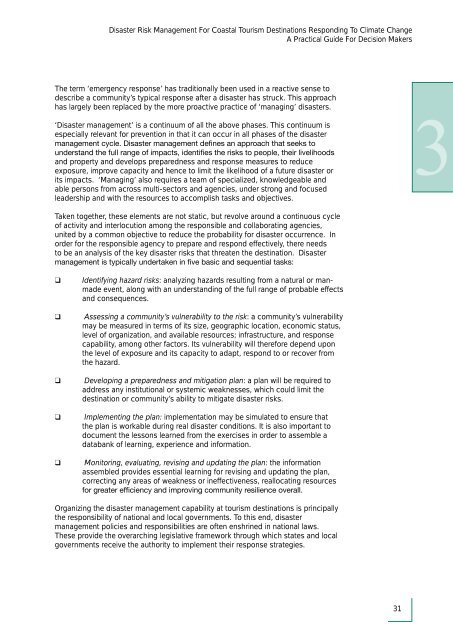Disaster Risk Management For Coastal Tourism Destinations - DTIE
Disaster Risk Management For Coastal Tourism Destinations - DTIE
Disaster Risk Management For Coastal Tourism Destinations - DTIE
Create successful ePaper yourself
Turn your PDF publications into a flip-book with our unique Google optimized e-Paper software.
<strong>Disaster</strong> <strong>Risk</strong> <strong>Management</strong> <strong>For</strong> <strong>Coastal</strong> <strong>Tourism</strong> <strong>Destinations</strong> Responding To Climate Change<br />
A Practical Guide <strong>For</strong> Decision Makers<br />
The term ‘emergency response’ has traditionally been used in a reactive sense to<br />
describe a community’s typical response after a disaster has struck. This approach<br />
has largely been replaced by the more proactive practice of ‘managing’ disasters.<br />
‘<strong>Disaster</strong> management’ is a continuum of all the above phases. This continuum is<br />
especially relevant for prevention in that it can occur in all phases of the disaster<br />
<br />
<br />
and property and develops preparedness and response measures to reduce<br />
exposure, improve capacity and hence to limit the likelihood of a future disaster or<br />
its impacts. ‘Managing’ also requires a team of specialized, knowledgeable and<br />
able persons from across multi-sectors and agencies, under strong and focused<br />
leadership and with the resources to accomplish tasks and objectives.<br />
3<br />
Taken together, these elements are not static, but revolve around a continuous cycle<br />
of activity and interlocution among the responsible and collaborating agencies,<br />
united by a common objective to reduce the probability for disaster occurrence. In<br />
order for the responsible agency to prepare and respond effectively, there needs<br />
to be an analysis of the key disaster risks that threaten the destination. <strong>Disaster</strong><br />
<br />
<br />
<br />
<br />
<br />
<br />
Identifying hazard risks: analyzing hazards resulting from a natural or manmade<br />
event, along with an understanding of the full range of probable effects<br />
and consequences.<br />
Assessing a community’s vulnerability to the risk: a community’s vulnerability<br />
may be measured in terms of its size, geographic location, economic status,<br />
level of organization, and available resources; infrastructure, and response<br />
capability, among other factors. Its vulnerability will therefore depend upon<br />
the level of exposure and its capacity to adapt, respond to or recover from<br />
the hazard.<br />
Developing a preparedness and mitigation plan: a plan will be required to<br />
address any institutional or systemic weaknesses, which could limit the<br />
destination or community’s ability to mitigate disaster risks.<br />
Implementing the plan: implementation may be simulated to ensure that<br />
the plan is workable during real disaster conditions. It is also important to<br />
document the lessons learned from the exercises in order to assemble a<br />
databank of learning, experience and information.<br />
Monitoring, evaluating, revising and updating the plan: the information<br />
assembled provides essential learning for revising and updating the plan,<br />
correcting any areas of weakness or ineffectiveness, reallocating resources<br />
<br />
Organizing the disaster management capability at tourism destinations is principally<br />
the responsibility of national and local governments. To this end, disaster<br />
management policies and responsibilities are often enshrined in national laws.<br />
These provide the overarching legislative framework through which states and local<br />
governments receive the authority to implement their response strategies.<br />
31

















